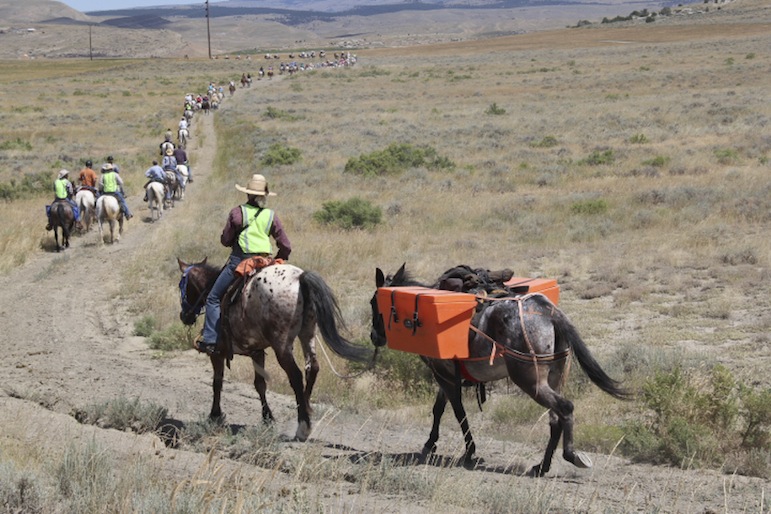Last Best News (https://montana-mint.com/lastbestnews/2014/07/crossing-paths-with-chief-joseph-trail-riders/)

Last Best News (https://montana-mint.com/lastbestnews/2014/07/crossing-paths-with-chief-joseph-trail-riders/)

I was down near Bridger today working on a story (look for it in a few days) when a very large group of people on horseback trotted into view, making their way across the parched hills a few miles south of town.
There were way too many people for a dude ranch outing. Who were they? My curiosity was soon satisfied. This was the the Chief Joseph Trail Ride, sponsored by the Appaloosa Horse Club of Moscow, Idaho, as I was told by Ron Fowler, chief scout.
Since 1965, the club has covered 100 miles a year of the Nez Perces’ fighting retreat of 1877, an 1,300-mile journey from eastern Oregon to a point 40 miles from the Canadian border, north of the Bear Paw Mountains near Havre.
This year’s five-day leg of the journey runs from Clark, Wyo., to the Canyon Creek Battlefield Monument north of Laurel. Fowler said the group of riders numbers 130, with participants from four countries and 21 states. All are welcome, but riders must have a registered Appaloosa.
I caught up with them briefly, at the tail end of a short lunch break, so I didn’t have time to talk much, but I heard a few stories and got some photos, which you can see in the gallery above.

Ed Kemmick/Last Best News
Rielly Leighton
Among the riders was Rielly Leighton, a Nez Perce from Lapwai, Idaho, and a member of the Nez Perce Appaloosa Horse Club, headquartered in Lapwai.
Leighton said he has been on the trail for the past five summers, since the beginning of the current 13-year cycle, and hopes to keep going until reaching trail’s end. He said he heard a lot about the epic journey from his grandparents.
What attracted him to the trail ride was “pretty much the history of the ride,” he said, “and the chance, not to relive it, but appreciate it.”
The flight of the Nez Perce was precipitated by the U.S. government’s attempt to force the tribe to give up its ancestral lands in the Pacific Northwest and relocate to a reservation in Idaho. Several bands of Nez Perce, known as the “non-treaty Indians,” refused to go.
After a battle in June of 1877, a band of some 750 Nez Perce, many of them women, children and old people, began the trek, pursued by elements of the U.S. Army. Though greatly outnumbered, the Nez Perce continually outmaneuvered the Army and won several battles and skirmishes on their flight to Canada.
The best known of the Indian leaders was Chief Joseph, who delivered his famous “fight no more forever” speech at the surrender.